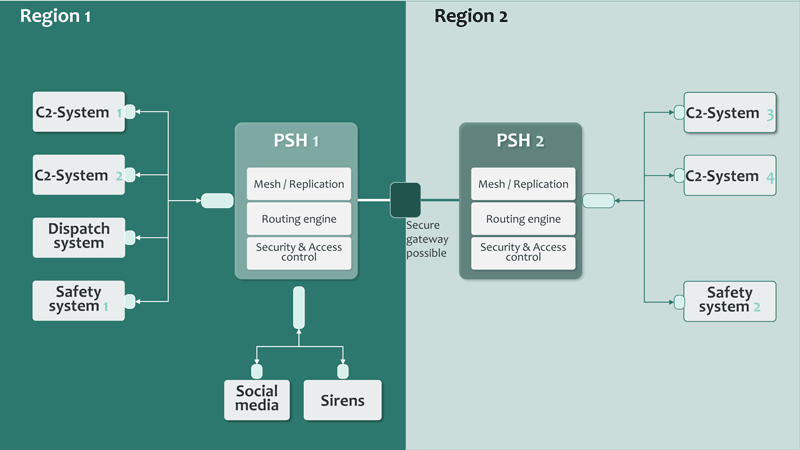by Mario Drobics, Alexander Preinerstorfer and Andrés Carrasco (AIT Austrian Institute of Technology)
Managing a global pandemic requires constant analysis of the current situation and corresponding responses. An open message bus can help organisations achieve a common operational picture across system boundaries, thus ensuring efficiency and effectiveness of their efforts.
In recent decades, many isolated information technology solutions have been developed within the field of crisis management (CM), which very specifically describe, interpret and present information for each organisation. The challenge is to share information about observations, resources and approaches between organisations such as first responders and local crisis management units.
Especially in complex situations like the ongoing COVID-19 pandemic, information from many different sources, like first responders, hospitals, laboratories and national crisis management centres, is needed to assess the current situation, develop strategies and coordinate their efforts [1].
Requirements
There is a clear need for a cross-organisational information exchange. Recent collaborative projects involving various stakeholders have identified some key requirements to achieve this:
- A decentralised platform for sharing information with one or multiple C2 systems, negating the need for a central data storage
- Lightweight standardised interfaces to reduce implementation efforts
- Logging of all activities in the system to fulfil documentation requirements
- The ability to join the platform later and receive previously sent objects on demand
- A resilient and secure design to ensure operation even in the case of (partial) failure.
Design of the Public Safety Hub
Based on these requirements, AIT has developed a communication backbone called Public Safety Hub (PSH) [L1]. The special technological architecture of the PSH enables secure and flexible data exchange between most diverse organisations without creating numerous dependencies and single points of failures. The data is exchanged in the form of protocol-agnostic messages through a lightweight REST interface, allowing the simple integration of systems without predefined protocols. Messages can be delivered to a specific recipient or through broadcast channels. These broadcast channels can be open or organised using a topological hierarchy of addresses, enabling a tailored information exchange for any organisational structure.
The PSH utilises an elastic federated design to ensure the resilience and division of responsibilities required by the CM and other public safety domains (see Figure 1). Each organisation has its own structure, workflow, and responsibility. Through the flexible design of the PSH, each federated instance can be fitted to the specific needs of an organisation. Moreover, its elastic design allows the PSH to scale to the size of the organisation, which increases performance and reliability. Federated instances of the PSH are independent and isolated. However, they can be interconnected in a mesh of federated instances, enabling information exchange on any organisational or pan-organisational structures, while keeping the internal information exchange isolated.

Figure 1: Federated architecture of the Public Safety Hub enabling resilient and flexible information exchange in the CM domain.
In order to gather a common operational picture, messages in the CM domain are often exchanged based on the EMSI (Emergency Management Shared Information) data model, as defined in the ISO Technical Report 22351. EMSI enables the peer-to-peer exchange of information on the same hierarchical level, as well as across the command structure. A simple PSH client can use an extension of the EMSI data model based on XML. To ensure the validity of the transmitted messages, all messages are checked regarding their syntactical conformity and semantical correctness. The latter is done by referring to a pre-defined EMSI data dictionary, which can be easily expanded. These messages can then be exchanged with any C2 system using the standardised PSH interface, overcoming the need to implement specific interfaces for each different C2 system. This enables end-users to focus on the information exchange rather than on the integration of different systems and organisations.
Evaluation
The initial evaluation of the public safety hub was carried out as part of a larger crisis management exercise in October 2018 in Murau (Austria). In this evaluation, four different civil and military C2 Systems where connected using the PSH. Technical and usability evaluations where carried out. The evaluation showed a high level of satisfaction from stakeholders regarding efficiency, simplicity and robustness of the solution.
Outlook
The modular and open design allows the PSH to bundle separate competencies and ensure a highly secure and efficient cooperation of different organisations in crisis situations like the current pandemic. Fully automated data exchange between the information systems is thus ensured. This can reduce the effort needed to enter data, increase consistency of information across stakeholders, and reduce time to obtain a situational picture. Thus, decisions can be based on broader and more accurate sets of data, ensuring efficiency and effectiveness in fighting the current pandemic and other crises.
Future research will focus on automated process support and semantic mapping between different protocols and domains.
Link:
[L1] http://www.public-safety-hub.com/
Reference:
[1] A. Preinerstorfer et al.: “Interoperability Between IT Systems in Austrian National Crisis & Disaster Management,” 2018 5th International Conference on Information and Communication Technologies for Disaster Management (ICT-DM), Sendai, Japan, 2018, pp. 1-8, doi: 10.1109/ICT-DM.2018.8636381
Please contact:
Mario Drobics, AIT Austrian Institute of Technology, Austria










